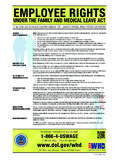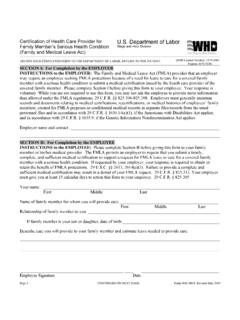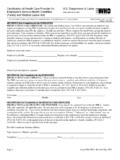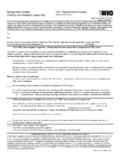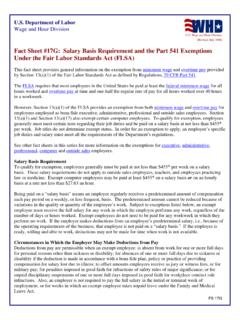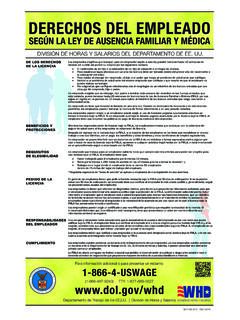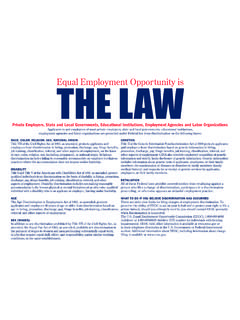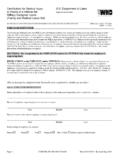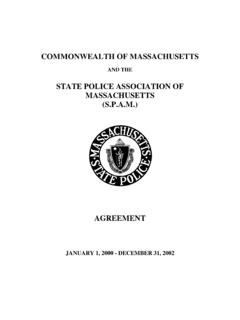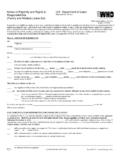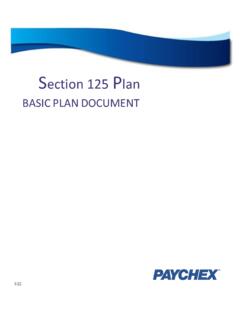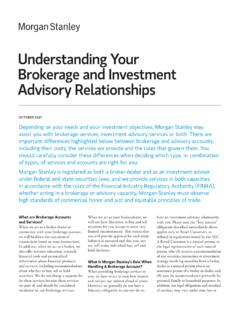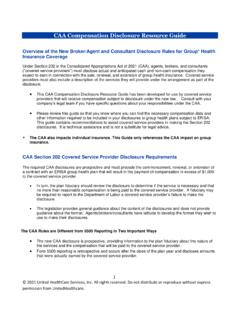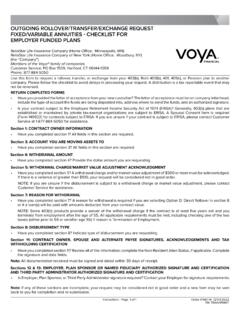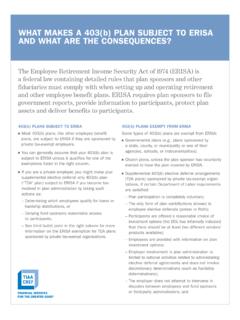Transcription of Voluntary Fiduciary Correction Program Fact Sheet
1 Fact Sheet Department of Labor employee Benefits security Administration December 2018. Voluntary Fiduciary Correction Program On April 19, 2006, the Department of Labor published in the Federal Register a 2006 Update of the Voluntary Fiduciary Correction Program (VFCP), which simplified and expanded the original VFCP. published in 2002. The VFCP is designed to encourage employers to voluntarily comply with the employee retirement income security Act ( erisa ) by self-correcting certain violations of the law. Many workers can benefit from the VFCP as a result of the increased retirement security associated with restoration of plan assets and payment of additional benefits. It also will help plan officials understand the law. The 2006. Update of the VFCP describes how to apply, the 19 categories of transactions covered, acceptable methods for correcting violations, and examples of potential violations and corrective actions.
2 The Department issued the Update in response to public and internal comments on the preliminary revision of the VFCP. published in April 2005. The 2006 Update of the VFCP was effective May 19, 2006. The Department also provides applicants conditional relief from payment of excise taxes for certain VFCP. transactions under a class exemption related to the VFCP, which is discussed in more detail below. The amended class exemption was also effective on May 19, 2006. Who Is Eligible Anyone who may be liable for Fiduciary violations under erisa , including employee benefit plan sponsors, officials, and parties in interest, may voluntarily apply for relief from enforcement actions, provided they comply with the criteria and satisfy the procedures outlined in the VFCP.
3 VFCP Criteria Persons using the VFCP must fully and accurately correct violations. Incomplete or unacceptable applications may be rejected. If rejected, applicants may be subject to enforcement action, including assessment of civil monetary penalties under Sections 502(l) and 502(i) of erisa . How to Apply Applicants do not need to consult or negotiate with EBSA to use the VFCP. They merely need to follow the procedures outlined in the notice published in the April 19, 2006, Federal Register. Violations can be fully and correctly resolved in four easy steps: Identify any violations and determine whether they fall within the transactions covered by the VFCP;. Follow the process for correcting specific violations ( , improper loans or incorrect valuation of plan assets).
4 2. Calculate and restore any losses or profits with interest, if applicable, and distribute any supplemental benefits to participants; and File an application with the appropriate EBSA regional office that includes documentation showing evidence of corrective action taken. Covered Transactions The VFCP provides descriptions of 19 categories of transactions and their methods of Correction . Corrective remedies are prescribed for the following Fiduciary violations involving employee benefit plans: Delinquent Participant Contributions and Participant Loan Repayments to Pension Plans Delinquent Participant Contributions to Insured Welfare Plans Delinquent Participant Contributions to Welfare Plan Trusts Fair Market Interest Rate Loans to Parties in Interest Below Market Interest Rate Loans to Parties in Interest Below Market Interest Rate Loans to Non-Parties in Interest Below Market Interest Rate Loans Due to Delay in Perfecting security Interest Participant Loans Failing to Comply with Plan Provisions for Amount, Duration.
5 Or Level Amortization Defaulted Participant Loans Purchase of Assets by Plans from Parties in Interest Sale of Assets by Plans to Parties in Interest Sale and Leaseback of Property to Sponsoring Employers Purchase of Assets from Non-Parties in Interest at More Than Fair Market Value Sale of Assets to Non-Parties in Interest at Less Than Fair Market Value Holding of an Illiquid Asset Previously Purchased by Plan Benefit Payments Based on Improper Valuation of Plan Assets Payment of Duplicate, Excessive, or Unnecessary Compensation Improper Payment of Expenses by Plan Payment of Dual Compensation to Plan Fiduciaries Acceptable Corrections The VFCP provides rules for making acceptable corrections involving the transactions listed above.
6 Applicants generally must: Conduct valuations of plan assets using generally recognized markets for the assets or obtain written appraisal reports from qualified professionals that are based on generally accepted appraisal standards;. Restore to the plan the principal amount involved, plus the greater of lost earnings, starting on the date of the loss and extending to the recovery date, or profits resulting from the use of the principal amount, starting on the date of the loss and extending to the date the profit is realized;. Pay the expenses associated with correcting transactions, such as appraisal costs or fees associated with recalculating participant account balances; and Make supplemental distributions when appropriate to former employees, beneficiaries, or alternate payees, and provide proof of the payments.
7 3. VFCP Documentation Under the VFCP, applicants must provide supporting documentation to the appropriate regional office of EBSA. Required documentation generally includes: Copy of relevant portions of plan and related documents;. Documents supporting transactions, such as leases and loan documents, and applicable corrections;. Documentation of lost earnings amounts;. Documentation of restored profits, if applicable;. Proof of payment of required amounts;. Specific documents required for relevant transactions, as outlined in Section 7 of the VFCP;. Signed checklist; and Penalty of perjury statement. The VFCP also provides a model application form. While use of this model application form is entirely Voluntary , EBSA encourages its use to avoid common application errors that frequently result in processing delays or rejections.
8 Restitution to Plans Applicants must restore the plan, participants, and beneficiaries to the condition they would have been in had the breach not occurred. The VFCP includes an online calculator to assist applicants by automatically calculating Correction amounts that must be paid to the plan. Plans must then file, where necessary, amended returns to reflect corrected transactions or valuations. Applicants also must provide proof of payment to participants and beneficiaries, or properly segregate the affected assets in cases where the plan is unable to identify the location of missing individuals. Payment of the Correction amount may be made directly to the plan where distributions to separated participants would be less than $20 and the cost of Correction exceeds the distributions owed.
9 Excise Tax Exemption The Department has adopted an amendment to PTE 2002-51 to expand the relief under the exemption to additional transactions included in the 2006 Update of the VFCP. The class exemption provides relief from certain excise tax provisions of the Internal Revenue Code if the terms of the Program and exemption are met. Prior to the 2006 amendment, the exemption covered most transactions involving: Failure to timely remit participant contributions to plans;. Loans made at fair market interest rate by plans with parties in interest;. Purchases or sales of assets between plans and parties in interest at fair market value;. Sales of real property to plans by employers and leaseback of the property at fair market value and fair market rental value, respectively.
10 The amended exemption continues to provide excise tax relief for these four transactions, and also provides relief for two additional transactions: 4. Prohibited transaction violations involved in the purchase of an asset by a plan when the asset has been determined to be illiquid, and/or the subsequent sale of the illiquid asset by the plan;. Use of plan assets to pay expenses to a service provider for services that are characterized as settlor expenses, provided such payments were not expressly prohibited in the plan documents. Additionally, for de minimis situations involving delinquent participant contributions and/or the failure to transmit participant loan repayments, the Department has eliminated the notice requirement. Please refer to the class exemption to determine if you meet all the terms.
